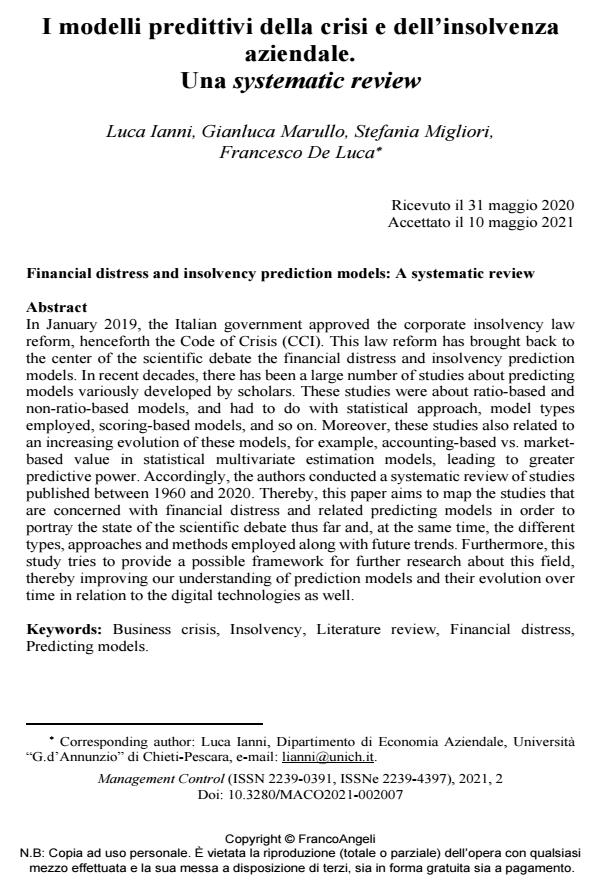Financial distress and insolvency prediction models: A systematic review
Journal title MANAGEMENT CONTROL
Author/s Luca Ianni, Gianluca Marullo, Stefania Migliori, Francesco De Luca
Publishing Year 2021 Issue 2021/2
Language Italian Pages 20 P. 127-146 File size 299 KB
DOI 10.3280/MACO2021-002007
DOI is like a bar code for intellectual property: to have more infomation
click here
Below, you can see the article first page
If you want to buy this article in PDF format, you can do it, following the instructions to buy download credits

FrancoAngeli is member of Publishers International Linking Association, Inc (PILA), a not-for-profit association which run the CrossRef service enabling links to and from online scholarly content.
In January 2019, the Italian government approved the corporate insolvency law reform, henceforth the Code of Crisis (CCI). This law reform has brought back to the center of the scientific debate the financial distress and insolvency prediction models. In recent decades, there has been a large number of studies about predicting models variously developed by scholars. These studies were about ratio-based and non-ratio-based models, and had to do with statistical approach, model types employed, scoring-based models, and so on. Moreover, these studies also related to an increasing evolution of these models, for example, accounting-based vs. market-based value in statistical multivariate estimation models, leading to greater predictive power. Accordingly, the authors conducted a systematic review of studies published between 1960 and 2020. Thereby, this paper aims to map the studies that are concerned with financial distress and related predicting models in order to portray the state of the scientific debate thus far and, at the same time, the different types, approaches and methods employed along with future trends. Furthermore, this study tries to provide a possible framework for further research about this field, thereby improving our understanding of prediction models and their evolution over time in relation to the digital technologies as well.
Keywords: Business crisis, Insolvency, Literature review, Financial distress, Predicting models.
- The relevance of cash flow information in predicting corporate bankruptcy in Italian private companies Simone Poli, Marco Gatti, in MANAGEMENT CONTROL 1/2024 pp.179
DOI: 10.3280/MACO2024-001009 - Human resources management, knowledge sharing and innovative behavior: Which nexus? A systematic literature review Arianna Becciu, Costina Andreea Calota, Cristina Gonnella, Sarah Russo, in MANAGEMENT CONTROL 3/2022 pp.13
DOI: 10.3280/MACO2022-003002 - Le performance dei modelli di credit scoring in contesti di forte instabilità macroeconomica: il ruolo delle Reti Neurali Artificiali Enrico Supino, Nicola Piras, in MANAGEMENT CONTROL 2/2022 pp.41
DOI: 10.3280/MACO2022-002003 - Early warning indicators: An empirical investigation in Italian context and first implications for corporate governance Raffaela Casciello, in Corporate Governance and Organizational Behavior Review /2021 pp.56
DOI: 10.22495/cgobrv5i2p5
Luca Ianni, Gianluca Marullo, Stefania Migliori, Francesco De Luca, I modelli predittivi della crisi e dell’insolvenza aziendale. Una systematic review in "MANAGEMENT CONTROL" 2/2021, pp 127-146, DOI: 10.3280/MACO2021-002007